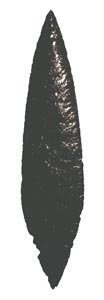Lithic period in Mesoamerica facts for kids
The Paleo-Indian period (also called the Lithic stage) is the earliest time in the history of Mesoamerica when humans first lived there. This period began when the very first people arrived in the Mesoamerican region. It ended when people started farming and developing early signs of civilizations.
Scientists believe this period ended around 9,000 years ago. After this, the Archaic period began, but the change wasn't sudden or clearly defined.
The exact start of the Paleo-Indian period is still debated. However, many researchers agree that people were living in the Americas by about 11,200 years ago.
What is the Paleo-Indian Period?
The Paleo-Indian period is the earliest part of human history in Mesoamerica. It's often called the "Lithic Period" because people mostly used stone tools during this time.
This period is considered "pre-ceramic" because people hadn't started making pottery yet. It's also part of the "pre-Columbian era," meaning it happened long before Christopher Columbus arrived in the Americas.
Scientists usually say this period ended around 8,000 BCE (Before Common Era). The start date is less certain, with estimates ranging from 12,000 to 20,000 years ago.
How Humans Arrived in Mesoamerica
Scientists have studied how humans first came to the Americas, including Mesoamerica. They look at ancient remains and tools, and how old they are.
At the start of the 1900s, many thought humans arrived in the Americas quite recently, after the last Ice Age. They believed people crossed a land bridge called Beringia (the Bering land bridge) from Asia. This was thought to be about 5,000 years ago.
However, new discoveries changed this idea. In the 1920s and 1930s, tools from the Folsom and Clovis cultures were found. These tools were much older. Folsom tools were about 10,000 to 11,000 years old. Clovis tools were even older, about 12,000 to 12,500 years old. This showed that people had arrived much earlier, possibly around 14,000 years ago.
Life in the Lithic Period
In Mesoamerica, the time from about 9,000 years ago back to the earliest human presence is called the "Paleoindian period." There is good evidence that humans lived in Mesoamerica around the same time as the Clovis people.
One important invention was the fluted spear point. These special spear tips made it easier to hunt large animals like mammoths. Evidence of mammoth hunting has been found in places like Santa Isabel Iztapan.
Scientists have found human bones from this period in places like Peña, Xico, Tepexpan, and San Vicente Chicoloapan. They use different methods to figure out how old these remains are. For example, they study the layers of earth where the bones were found. They also look at other animal bones or stone tools found nearby.
Some scientists believe humans might have been in the Americas even earlier. There are claims of human presence 20,000 to 30,000 years ago at sites like Meadowcroft Rock Shelter in Pennsylvania. In Mesoamerica, evidence from Tequixquiac and Tlapacoya suggests human occupation as far back as 23,000 years ago. The Valsequillo area has five sites that seem to be at least 20,000 years old. These findings suggest that humans might have arrived in the Western Hemisphere much earlier than previously thought.


